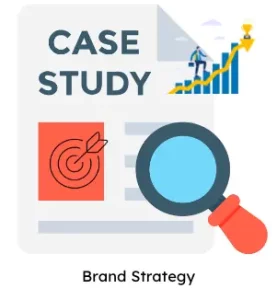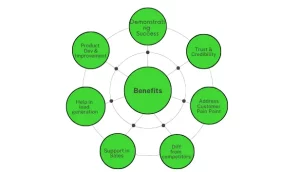How to Write Case Studies that Drive Sales?
Case study is a valuable asset in marketing because it provide real-world examples of how your products or services have solved specific problems or delivered successful customer outcomes.
They offer evidence and credibility, showcasing the effectiveness and value of your offerings. Case studies help potential customers understand how your solutions can address their challenges and give them confidence in choosing your brand. They are powerful tools for building trust, influencing purchasing decisions, and demonstrating your expertise in a tangible and relatable way.

If you are looking to build case studies to explain to your audience how your product can simplify things for them, read further.
What is a Case Study?
A case study is a detailed examination and analysis of a specific real-life situation, problem, or scenario. It involves researching and documenting the context, challenges, actions, and outcomes achieved in a particular business or customer scenario.

Case studies typically focus on showcasing the successful application of a product, service, or strategy, highlighting the results, benefits, and lessons learned. They provide a comprehensive narrative that helps readers understand a solution or approach’s practical implications and value. Case studies are commonly used in various fields, including marketing, business, education, and research, to provide in-depth insights and illustrate best practices.
Also Read: How to write website content that engages people?
Benefits of developing Case Studies
Developing case studies offers several benefits for businesses. Here are some key advantages:

Demonstrating success:
Case studies prove your product or service’s effectiveness. You can build credibility and instil confidence in potential customers by showcasing real-life examples of how your offerings have solved problems or achieved desired outcomes.
Building trust and credibility:
Case studies prove your capabilities and expertise. When prospective clients see how you have successfully addressed similar challenges, they are more likely to trust your brand and be confident in your ability to deliver results.
Addressing customer pain points:
Case studies allow you to specifically address common pain points or challenges your target audience faces. By presenting relatable scenarios and showcasing how your solutions have resolved those issues, you can resonate with potential customers and position your offerings as valuable problem-solvers.
Differentiating from competitors:
Case studies help you stand out by highlighting unique success stories and the specific benefits your products or services have delivered. They demonstrate your unique value proposition and showcase what sets you apart in the market.
Supporting the sales process:
Case studies serve as powerful sales tools. They provide your sales team with concrete examples and talking points to demonstrate the value and impact of your offerings. Case studies can be shared with potential customers during presentations, pitches, or as part of marketing collateral.
Generating leads and conversions:
Well-crafted case studies can attract the attention of potential customers actively seeking solutions to their problems. They can generate interest, lead to inquiries, and ultimately drive conversions by highlighting successful outcomes.
Informing product development and improvement:
Through case studies, you gain insights into how customers have used your offerings and the specific benefits they have derived. This feedback can be valuable for product development, identifying areas for improvement, and enhancing customer satisfaction.
Case Study Format for Marketing Agency
Developing a case study can be a point of introspection as well as that of claiming success.
If your business solution solves the problem of the audience, it can be a case study for your future reference. Follow the format to build a case study for a marketing agency.
Title: Give Client Name
Case Study: Give a title how a Marketing Agency brings in impact
Introduction:
- Briefly introduce the client and their industry.
- Highlight the challenges or goals the client wanted to address.
Client Background:
- Provide an overview of the client’s business, including their products/services, target audience, and market position.
- Describe any unique aspects or competitive advantages of the client.
Objectives:
- Clearly outline the specific objectives the client wanted to achieve through their marketing efforts.
- Include measurable goals such as increasing website traffic, improving brand awareness, generating leads, or boosting sales.
Approach:
- Explain the marketing agency’s strategic approach and tactics to meet the client’s objectives.
- Describe the research, planning, and execution process followed.
- Highlight any innovative or unique strategies employed.
Implementation:
- Detail the specific marketing activities executed, such as website redesign, SEO optimization, social media campaigns, content creation, PPC advertising, etc.
- Include timelines, milestones, and any challenges encountered during implementation.
Results:
- Present the measurable results achieved through the marketing agency’s efforts.
- Include quantitative data and key metrics such as increased website traffic, improved search rankings, social media engagement, lead generation, conversion rates, and revenue growth.
- Use charts, graphs, or visuals to illustrate the impact.
Testimonials or Quotes:
- Include quotes or testimonials from the client, highlighting their satisfaction with the marketing agency’s services and the results achieved.
- These can provide credibility and reinforce the success of the case study.
Lessons Learned:
- Discuss any valuable insights or lessons learned during the project.
- Reflect on challenges faced and how they were overcome.
- Share any adjustments made to the strategy based on data analysis and client feedback.
Conclusion:
- Summarise the overall impact of the marketing agency’s efforts on the client’s business.
- Emphasise the successful achievement of objectives and the tangible benefits experienced.
- Reinforce the value of the marketing agency’s services and expertise.
Call to Action:
- Encourage readers to contact the marketing agency for their own marketing needs.
- Provide contact information or a link to the agency’s website for further inquiries or consultations.
By following this case study format, the marketing agency can effectively showcase its capabilities, highlight its success stories, and attract potential clients by demonstrating the positive outcomes achieved for its previous clients.
Case Study Example
Let us read this case study to understand how brands worked to gain their success.
Title: Building a Brand: A Case Study on Boat

Introduction
In this case study, we explore the journey of Boat, a popular consumer electronics brand, and how it successfully established itself as a leading player in the audio and lifestyle industry.
Company Background
Boat is an Indian company specialising in manufacturing and selling audio products, including headphones, earphones, speakers, and accessories. With a vision to provide affordable yet high-quality audio solutions, Boat aimed to disrupt the market and carve a niche.
Marketing Objectives
The marketing objectives of Boat were to build brand awareness, establish credibility, expand its customer base, and drive sales in a highly competitive market. They aimed to position themselves as a brand that offers superior audio experiences at accessible price points.
Approach
Boat employed a comprehensive marketing approach to achieve its objectives. They focused on combining online and offline strategies, leveraging social media, influencer marketing, partnerships, and experiential marketing events. Boat adopted a customer-centric approach, ensuring its brand resonated with the target audience.
Strategies Implemented
- Digital Marketing: Boat utilised social media platforms, such as Instagram and YouTube, to showcase its products, engage with its audience, and build a community. They created visually appealing content, collaborated with influencers, and ran targeted online campaigns to generate buzz.
- Brand Partnerships: Boat strategically collaborated with popular celebrities, influencers, and sports personalities to endorse its products. These partnerships helped amplify their brand reach and build credibility among their target audience.
- Experiential Marketing: Boat organised experiential events, such as product launches, music festivals, and college campus activations, to allow customers to experience their products firsthand. These events created a buzz, generated word-of-mouth, and strengthened brand loyalty.
- Product Quality and Innovation: Boat consistently focused on delivering high-quality audio products with innovative features at competitive prices. Their commitment to providing value to customers played a significant role in establishing trust and loyalty.
Results and Success
Through its strategic marketing efforts, Boat achieved remarkable success. They witnessed exponential growth in brand awareness, gained a strong social media presence, and experienced a substantial increase in sales. The Boat became a preferred choice for audio enthusiasts and built a loyal customer base.
Conclusion
Boat’s case study exemplifies the power of a well-executed marketing strategy in building a brand. By leveraging digital marketing, brand partnerships, experiential events, and a focus on product quality, Boat successfully established itself as a prominent player in the audio industry. Their journey highlights the importance of understanding customer needs, delivering value, and creating a compelling brand story to drive growth and success.
Final Thoughts
Case studies are powerful tools to showcase real-world successes and demonstrate the tangible benefits of products or services. Through the in-depth analysis of specific challenges and the strategies employed to overcome them, case studies provide evidence of effectiveness and build credibility for businesses.
By highlighting the positive outcomes achieved, case studies inspire trust and confidence in potential customers, helping businesses differentiate themselves from competitors. If you want similar results or tailored solutions for your specific needs, we invite you to contact us today. Contact us for a consultation and let our expertise and proven track record drive your success.
FAQ
Is there a standard case study format?
Yes, there is a standard case study format that is commonly followed. While variations may exist depending on specific requirements, the typical structure of a case study includes the following sections:
- Introduction: Provides an overview of the case study and sets the context for the discussed topic or problem.
- Background: Describes the background information about the subject of the case study, such as the company, industry, or situation being analyzed.
- Problem Statement: Clearly defines the problem or challenge the case study aims to address or solve.
- Methodology: Explains the research methods, data collection techniques, or analytical approaches used in the case study.
- Analysis: Presents the findings of the case study, including data, evidence, or insights gathered during the research process.
- Solutions/Recommendations: Proposes potential solutions or recommendations based on the analysis conducted. These should be supported by the findings and aligned with the objectives of the case study.
- Conclusion: Summarises the key points discussed in the case study and reinforces the main takeaways or lessons learned.
What is a case study?
A case study thoroughly examines a real-world situation, project, or issue, usually in business or educational contexts. It delves into the history, difficulties, tactics, and results to offer helpful knowledge and takeaways.
Why are case studies necessary?
Case studies are important because they provide real-life examples and concrete proof of effective methods for problem-solving and goal achievement. They enhance comprehension of intricate situations and act as educational materials for both professionals and students
How are case studies conducted?
Case studies involve in-depth research, data collection, and analysis. They often employ various research methods, such as interviews, surveys, observations, and document analysis, to gather relevant information and insights.
What makes a good case study?
A good case study is well-structured, clearly defines the problem or objective, includes detailed research and analysis, and presents practical and actionable solutions or recommendations. It should also be engaging, well-written, and supported by evidence and data.
Who uses case studies?
Case studies are widely used by businesses, researchers, and educational institutions. They are utilised by professionals for benchmarking, decision-making, and learning from successful practices. Academics and students use case studies for analysis, research, and classroom discussions.
How can case studies benefit businesses?
Case studies can benefit businesses by showcasing their expertise, success stories, and problem-solving capabilities. They build credibility, attract potential clients, and provide insights for improving strategies and decision-making.
Can case studies be used for marketing purposes?
Yes, marketing frequently uses case studies to demonstrate the value and effectiveness of products or services. They provide evidence of successful outcomes, address customer pain points, and influence purchasing decisions by showcasing real-world examples.



